TALLY T2030-24, T2030-9, T2130, T2130-24, T2130-9 User Manual
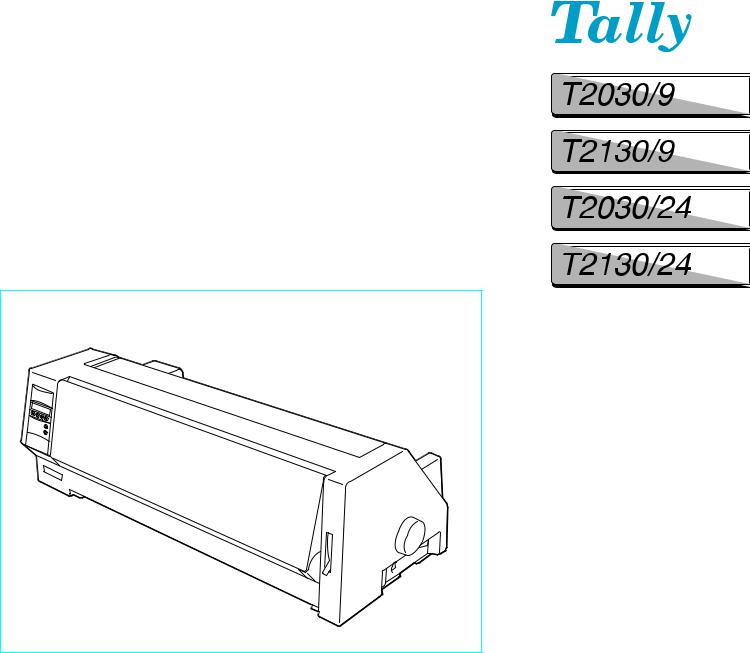
®
Operator’s Manual |
Matrix Printer |
Bedienungsanleitung |
Matrixdrucker |
Manuel d’utilisation |
Imprimante matricielle |
Istruzioni per l’uso |
Stampante a Matrice |
Instrucciones de servicio |
Impresora matricial |

Important Information
This equipment generates and uses radio frequency energy and if not installed and used properly, that is, in accordance with the manufacturer’s instructions, may cause interference in radio and television reception. It has been type tested and found to comply with the limits for class B computing devices in accordance with the specification in subpart J of part 15 of FCC rules, which are designed to provide reasonable protection against such interference in a residential installation. However, there is no guarantee that interference will not occur in a partial installation. If this equipment does cause interference to radio or television reception, which can be determined by turning the equipment off and on, the user is encouraged to try to correct the interference by one or more of the following measures:
Reorient the receiving antenna,
Relocate the peripheral away from the receiver,
Move the peripheral away from the receiver
Plug the peripheral into a different outlet, so that the peripheral and receiver are on different branch circuits
If necessary, the user should consult the dealer or an experienced radio/television technician for additional suggestions. The user may find the following booklet, prepared by the Federal Communications Commission, helpful: “How to Identify and Resolve Radio-TV Interference Problems”.
This booklet is available from the U.S. Government Printing Office, Washington DC 20402 Stock No. 004.000.00345.4.
WARNING: To comply with FCC regulations on electromagnetic interference for a class B computing device, the printer cable must be shielded. To assure compliance with FCC regulations for a computing device, use a shielded interface cable with a metal shell connector. The use of cables not properly shielded may result in violating FCC regulations.
This digital apparatus does not exceed the class B limits for radio noise emissions from digital apparatus as set out in the radio interference regulations of the Canadian department of communications.
This unit complies with DOC standard C108.8-M 1983
ATTENTION: Le présent appareil numérique n’ement pas de bruits radioélectriques déspassant les limites applicables aux appareils numériques de la classe B prescrites dans le règlement sur le brouillage radioélectrique édicté par le minstère des communications du Canada.
The paper used is made of raw materials treated with a chlorine-free bleaching process.
Das verwendete Papier ist aus chlorfrei gebleichten Rohstoffen hergestellt.
Le papier utilisé est fabriqué à partir de matières premières blanchis sans chlore.
La carta utilizzata è prodotta con materiali sbiancati senza cloro.
El papel utilizado ha sido fabricado con un proceso de blanqueo libre de cloro.
This device fulfils the European standards requirements by complying with the Directive of the Commission dated May 3, 1989 (89/336/EEC) relating to electromagnetic compatibility and the Directive dated February 19, 1973 (73/23/EEC) relating to low-voltage electrical equipment. Conformity with the above mentioned Directives
is indicated by the CE symbol attached to the device. Note: Conformity may be affected by:
using interface cables not complying with the specifications
non-observance of important instructions in the operator’s manual
installing components not approved for this device by the manufacturer
unauthorized manipulation
Dieses Gerät erfüllt die Anforderungen der Europäischen Normen durch Einhaltung der Richtlinie des Rates vom 3. Mai 1989 (89/336/EWG) bezüglich der Elektromagnetischen Verträglichkeit sowie die Richtlinie vom 19. Februar 1973 (73/23/EWG) bezüglich Elektrischer Betriebsmittel mit Niederspannungen. Die Konformität zu
den oben angeführten Richtlinien ist durch das am Gerät angebrachte CE-Zeichen gekennzeichnet. Hinweis: Die Konformität kann beeinflußt werden durch:
Benutzung von nicht spezifizierten Schnittstellenkabeln
Nichtbeachtung wichtiger Hinweise der Bedienungsanleitung
Ersetzen von Bauteilen, die nicht vom Hersteller für dieses Gerät freigegeben wurden
Eingriffe durch Unbefugte
Cet appareil remplit aux exigences des normes européennes en respectant la directive du Conseil du 3 mai 1989 (89/336/CE) relative à la compatibilité électromagnétique et la directive du 19février 1973 (73/23/CE) en matière du matériel à basse tension. La conformité aux directives mentionnées ci-dessus est repérée par la
marque de conformité de la Communauté Européenne (CE). Remarque: La conformité peut être influencée par:
l’utilisation de câbles d’interface non spécifiés
le non-respect de consignes importantes du manuel d’utilisation
le remplacement de composants qui n’ont pas été homologués pour cet appareil par le constructeur
l’intervention de personnes non autorisées
Questo apparecchio soddisfa le richieste delle norme europee rispettando la direttiva del consiglio del 3 Maggio 1989 (89/336/CEE) relativa alla compatibilità elettromagnetica nonché la direttiva del 19 Febbraio 1973 (73/23/CEE) relativa a mezzi di produzione elettrici a bassa tensione. La conformità alle direttive sopra citate
è contrassegnata con il simbolo CE applicato sull’apparecchio.
Nota: La conformità può essere influenzata tramite:
Utilizzo di cavi interfaccia non specificati
Inosservanza di importanti indicazioni delle istruzioni per l’uso
Sostituzione di componenti per i quali non è stato dato il benestare dal produttore per questo apparecchio
Interventi tramite persone non autorizzate
Este equipo corresponde a lo exigido en las normas europeas a base del cumplimiento de la directriz del Consejo del 3 de mayo de 1989 (89/336/CEE) en lo que se refiere a la compatibilidad electromagnética así como de la directriz del 19 de febrero de 1973 (73/23/CEE) en lo que se refiere a los materiales eléctricos con bajas
tensiones. Para señalizar la conformidad con las directrices antes mencionadas, el equipo está dotado de la marca CE.
Indicación: La conformidad puede estar influida por:
la utilización de cables de interface no especificados
 la inobservancia de indicaciones importantes contenidas en el manual de servicio
la inobservancia de indicaciones importantes contenidas en el manual de servicio
la sustitución por componentes, que no han sido homologados por el fabricante para el equipo en cuestión
intervenciones de personas no autorizadas
WARNING Only trained and qualified personnel may open covers or remove parts that are not explicitly shown and described in the User Guide as being accessible to the operator.
WARNUNG Das Entfernen oder Öffnen von Abdeckungen und Teilen darf nur durch geschultes Fachpersonal vorgenommen werden. Ausgenommen hie rvon sind nur solche Abdeckungen und Teile, deren Entfernen bzw. Öffnen in der Bedienungsanleitung ausdrücklich gekennzeichnet und beschriebe n sind.
ATTENTION Seul un personnel qualifié et formé est habilité à démonter les sous-ensembles de la machine qui ne sont pas formellement indiqués dans le Manuel d’utilisation meme s’ils sont accessibles par l’opérateur.
ATTENZIONE Solo personale qualificato puo’accedere a parti che non siano esplicitamente descritte nelle Istruzioni per l’operatore come accessibill all’operatore.
ADVERTENCIA Las cubiertas y piezas sólo deberán ser quitadas o abiertas por personal especializado. Se exceptúan de esta regla sólo las cubiertas y piezas cuya retirada y apertura estén indicadas y descritas expresamente en las Instrucciones de uso.
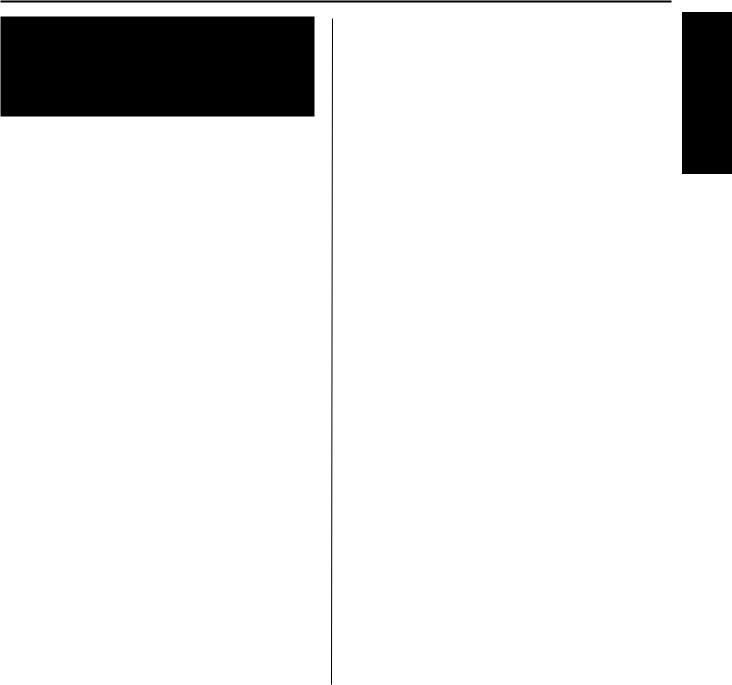
Quick start-up
Operator’s Manual
QUICK START-UP
Table of contents
Introduction |
2 |
Symbols used in this manual |
2 |
Important safety instructions |
2 |
Using the online documentation |
2 |
Troubleshooting |
2 |
The printer at a glance |
3 |
Installation |
5 |
Unpacking the printer |
5 |
Positioning your printer |
5 |
Connecting the printer |
6 |
Switching the printer on and off |
6 |
Control panel |
7 |
Online mode |
7 |
Offline mode |
7 |
Setup mode |
7 |
Installing the ribbon cassette |
8 |
Loading paper |
10 |
Cut Sheet paper |
10 |
Printer in fanfold paper mode |
12 |
Changing the paper type |
14 |
Paper path quick selection |
14 |
Paper transport |
15 |
Using |
15 |
Moving paper to the tear position |
15 |
Settings (I) |
16 |
Setting the tear position |
16 |
Setting the first printing line (TOF) |
16 |
Settings (II) |
18 |
Setting the print head gap |
18 |
Changing paper in Setup mode |
19 |
From fanfold paper to single sheet mode |
19 |
From single sheet to fanfold paper mode |
20 |
Selecting a font |
21 |
Setting the character pitch |
22 |
Specifications |
23 |
Printer specifications |
23 |
Paper specifications |
23 |
Accessories |
24 |
ENGLISH
1

Introduction |
Quick start-up |
Introduction
Ah ha!
Symbols used in this manual
STOP
This Operator’s Manual is intended as a quick introduction into working with the printer and is to enable also unexperienced users to handle the device properly. It describes the most important functions of the printer and contains the essential information for your everyday work with the printer. A more detailed description of the printer, its characteristic features and further information is contained in the reference manual on the online CD-ROM which is included at the back of this manual.
Important information is highlighted in this manual by two symbols.
CAUTION marks information which must be observed in order to prevent injuries to the user and damage to the printer.
NOTE marks general or additional information about a specific topic
Important safety instructions
STOP
STOP
Using the online documentation
Troubleshooting
Read the following instructions carefully before putting the printer into operation in order to protect yourself from injury and avoid damage to the printer.
Keep this Operator’s Manual always readily accessible.
Place the printer on a stable surface so that it cannot fall down to the ground.
Avoid exposing the printer to high temperature or direct sunlight.
Keep all liquids away from the printer.
Do not expose the printer to shock, impact or vibration.
Never switch on the printer when it is not set to the correct voltage.
Never try to carry out maintenance and repair work yourself; always call a qualified service technician.
When you want to disconnect the printer from the mains power supply, always pull out the mains plug from the wall outlet.
You will find additional safety information at specific places in the text.
First install the Adobe Acrobat Reader on your hard disk unless the program has already been installed. To install it, follow the steps described in the README file in the READER directory. To start the online documentation, call the File Manager (Windows 3.1) or Explorer (Windows 95/Windows 98/Windows NT) and double click on the START.PDF file. Then follow the instructions and menus on the screen.
If your CD-ROM should be defective or missing, please consult your dealer.
The online documentation is also available as a printed manual (for a small fee) and via the internet.
Minimum hardware requirements: PC AT 486, 4 x CD-ROM, 15" monitor, mouse.
The online documentation supplied on the CD-ROM contains detailed information on troubleshooting.
2
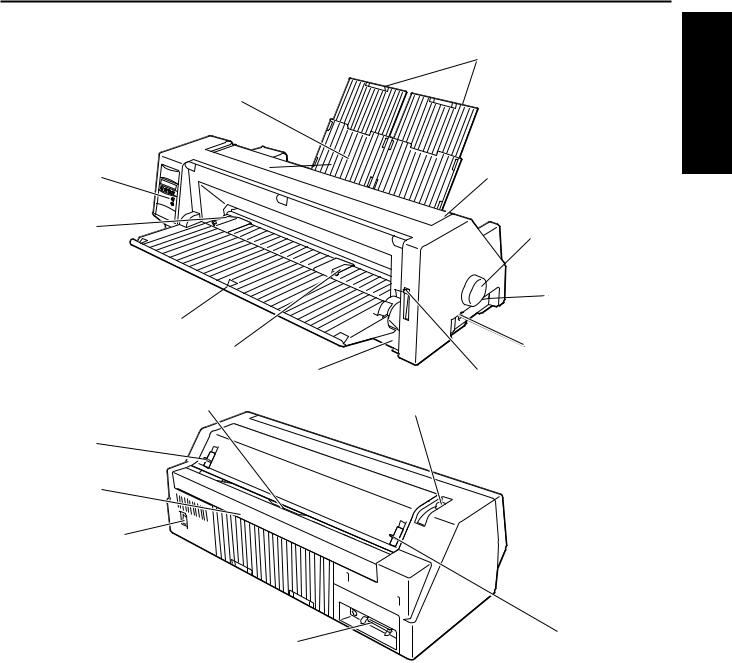
Quick start-up |
The printer at a glance |
The printer at a |
The following figures show the name of each printer part, and the table on the following page |
glance |
shows the functions of each part. |
|
Paper Extension Trays |
|
Paper Tray |
Operation Panel |
Access Cover |
|
|
Left Paper Guide |
Paper Feed Knob |
|
|
|
Power Switch |
Cut Sheet Paper Insert Guide |
|
Right Paper Guide |
Option Connectors |
Front Cover |
Paper Type Selection Lever |
Perforated Line Cutter |
Paper Thickness Adjustment Lever |
|
|
Latch Lever |
|
Rear Covere |
|
Power Inlet |
|
Latch Lever
Interface Connector
ENGLISH
3

The printer at a glance |
Quick start-up |
|
|
|
|
|
|
|
|
Name |
Functions |
|
Operation Panel |
It indicates the printer status, and is used to change various settings. |
|
|
|
|
Paper Tray |
It is used as a paper support for cut sheet paper already printed when the |
|
|
option “F-Eject” is set to OFF in the Initial Setting. |
|
Paper Extension Trays |
They are used for extending of the Paper Tray. |
|
|
|
|
Access Cover |
When the Ink-ribbon Cartridge is to be replaced or paper jams are to be |
|
|
removed, this cover is detached to allow access to the related parts. It also |
|
|
serves to protect operators from the mechanical movements of the printer. |
|
|
|
|
Paper Feed Knob |
It is used to manually feed paper forward or backward. |
|
|
|
|
Power Switch |
It is used to turn ON or OFF the power of the printer. |
|
|
|
|
Option Connector |
It is used to connect an Auto Sheet Feeder (ASF) or the Optional 2nd |
|
|
Tractor. |
|
Paper Type Selection |
It is used to select the appropriate type of paper to be used in the printer: |
|
Lever |
Cut Sheet Paper (upper position) |
|
|
Continuous Form Feed Paper (lower position) |
|
|
|
|
Front Cover |
It is opened when Continuous Form Feed Paper is to be set. This cover is |
|
|
detached when an Auto Sheet Feeder (ASF) or the Optional 2nd Tractor is |
|
|
to be attached. |
|
|
|
|
Right Paper Guide |
By aligning the right edge of the Cut Sheet Paper to this guide, an uneven |
|
|
feed can be prevented. |
|
|
|
|
Cut Sheet Paper Insert |
It is opened for inserting Cut Sheet Paper and is used as a paper support. |
|
Guide |
It is also used as a support for post-print Cut Sheet Paper when the option |
|
|
“F-Eject” is set to ASF, Single or ALL in the Initial Setting. |
|
Left Paper Guide |
It is used to adjust the left margin of the Cut Sheet Paper. |
|
Latch Lever |
By pulling this lever to the front, the latch is released and the Access |
|
|
Cover can be opened. |
|
|
|
|
Perforated Line Cutter |
Continuous Form Feed Paper will be cut at this position. By pressing the |
|
|
Tear key after printing, paper feeds up to this position. |
|
|
|
|
Paper Thickness Ad- |
It is used to adjust the paper-pinching strength of the printer in accordance |
|
justment Lever |
with the thickness of the paper to be used. As for the adjustment ranges, |
|
|
see Paper Thickness Adjustment, page 18. |
|
|
|
|
Interface Connector |
It is used to connect the I/O cable to the system unit. |
|
|
|
|
Power Inlet |
It connects to the power cord. |
|
|
|
|
Rear Cover |
It is used to reduce noise. It must be removed when the paper tray is in |
|
|
upright position. |
|
|
|
4
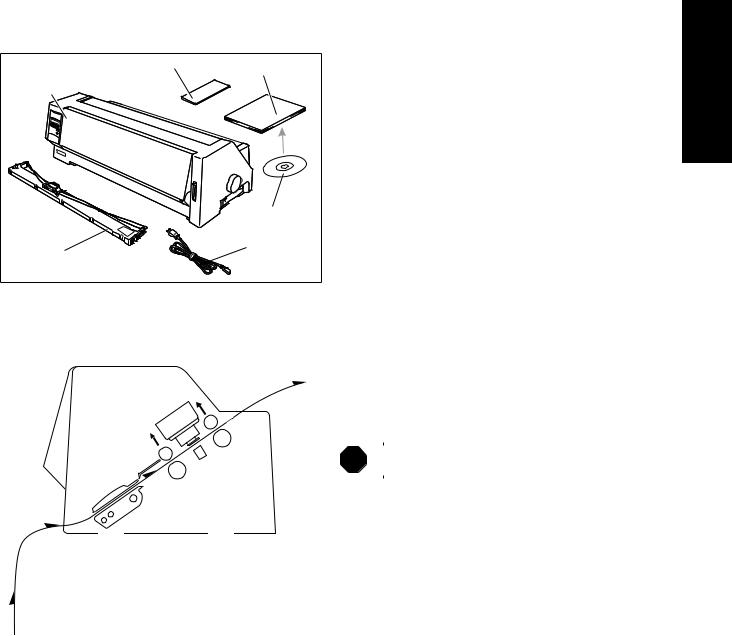
Quick start-up |
Installation |
Installation
Unpacking the printer Please open the printer package and check that all the following items are included.
Unpacking Instructions |
Operator’s Manual |
Printer |
|
|
CD-ROM |
Ink-ribbon |
Power Cord |
|
If any item is missing or damaged, please contact the store where the product was purchased.
Remove the transport protection elements as described in the unpacking instructions.
The carton and the packing materials will be necessary for moving or transporting the printer. Please store them in a safe place.
Positioning your |
Place the printer on a stable, flat and non-slip surface in such a way that it cannot fall down. |
||||||||
printer |
Ensure easy access to the control panel and the paper feeders and leave sufficient space for the |
||||||||
|
|
|
paper ejected. |
||||||
|
|
|
|
|
|
|
If frequent forward and return feed movements will be perfor- |
||
|
|
|
|
|
|
|
|||
|
|
|
|
|
|
|
med with fanfold paper, you should position the printer as |
||
|
|
|
|
|
|
|
illustrated in the figure. |
||
|
|
|
|
|
|
|
When choosing a suitable place for your printer, you should also |
||
|
|
|
|
|
|
|
observe the following: |
||
|
|
|
|
|
|
|
STOP |
|
Never place the printer near sources of easily in- |
|
|
|
|
|
|
|
|
||
|
|
|
|
|
|
|
|
flammable gas or explosive substances. |
|
|
|
|
|
|
|
|
|
|
|
|
|
|
|
|
|
|
■ Avoid exposing the printer to direct sunlight. If you cannot |
||
|
|
|
|
|
|
|
avoid placing the unit near a window, protect it from sunlight |
||
|
|
|
|
|
|
|
with a curtain. |
||
|
|
|
|
|
|
||||
|
|
|
|
|
|
|
■ Position the printer near the computer to which it will be |
||
|
|
|
|
|
|
|
connected. The distance must not exceed 2 m. |
||
|
|
|
|
|
|
|
■ Ensure sufficient distance from radiators. |
||
|
|
|
|
|
|
|
■ Ensure that the printer is not exposed to extreme variations |
||
|
|
|
|
|
|
|
in temperature or air humidity. Avoid exposure to dust. |
||
|
|
|
|
|
|
|
|
|
|
|
|
|
|
|
|
|
|
|
|
ENGLISH
5
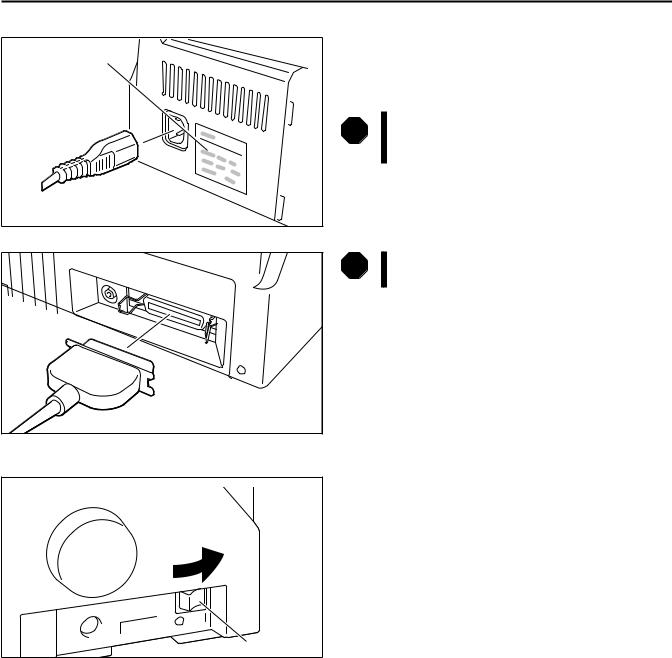
Installation |
|
Quick start-up |
Connecting the printer |
|
|
|
Make sure that the unit is set to the correct voltage (i.e. 230 V |
|
Type Plate |
for Europe, 120 V for the USA). Refer to the type plate beside |
|
|
the power inlet on the rear side of the printer. |
|
|
If this is not the case, contact your dealer. |
|
|
STOP |
Never switch on the printer when it is not set to the |
|
correct voltage since this could cause severe da- |
|
|
|
|
|
|
mage. |
|
Connect the power cable to the printer’s power |
|
|
inlet as shown in the figure. |
|
|
Connect the power cable plug to a wall outlet. |
|
|
STOP |
Make sure that the printer and the computer are |
|
|
switched off. |
|
Connect the printer-end connector of the data |
|
|
cable to the female interface connector and secure it with the |
|
|
spring clips. |
|
|
Connect the other end of the cable to the computer. |
|
Switching the printer on and off |
|
|
|
The power switch, which is used for switching the printer on |
|
|
and off, is located at the right side of the printer. |
|
Power Switch
6
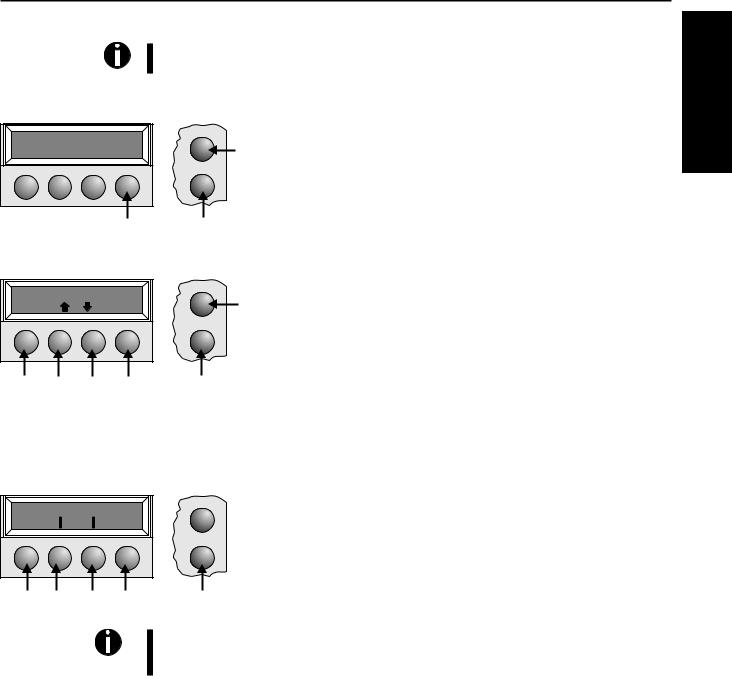
Quick start-up |
|
|
Control panel |
Control panel |
You can control printer operation using the control panel and the keys. |
||
|
|
The first line of the display informs you about whether the printer is in Online or in Offline |
|
|
|
mode and about the paper path selected (Trac.1 or Single). |
|
Online mode |
When switching on the printer, it automatically selects Online mode. It can receive data from the |
||
|
|
computer only in this mode. |
|
Online |
Trac.1 |
Online |
Sets the printer to Offline mode. |
|
Sets the printer to Setup mode. |
||
|
Tear |
|
|
|
|
Setup |
Tear key: Activates the tear function when fanfold paper is loaded |
|
|
|
(see page 15). If Load is displayed above this key, no paper is loaded in |
|
|
|
the printer; press the key to feed paper to the printing position. |
|
|
|
|
Offline mode |
Step feeds, line feeds and form feeds can be performed via the control panel only in this mode |
||
|
|
(see page 15). |
|
Offline |
Trac.1 |
Online |
||
|
||||
Park |
|
|
LF/FF |
|
|
|
|
|
Setup |
|
|
|
|
|
Setup mode |
|
|
|
Adjust |
Paperway |
Online |
|
|
|||
Menu |
|
Char |
|
|
|
|
Setup |
|
|
|
|
Sets the printer to Offline mode.
Sets the printer to Setup mode.
If no paper is loaded: Load key (see above). If paper is loaded:
Short keypress: Line feed (LF)
Long keypress: Form feed (FF)
Short keypress: Micro-step return
Long keypress: Constant paper feed return
Short keypress: Micro-step forward
Long keypress: Constant paper feed forward
Clears the paper path with paper loaded and activates paper path quick selection (see page 14).
Sets the printer to Setup mode. In this mode, the following settings are available:
Sets the font and the number of characters per inch (Char menu).Paper path (Paperway menu)
Tear position and first printing line (Adjust menu)
Other menu settings (Menu)
Access to the other menu options is disabled by the manufacturer. For information on how to enable access to these options as well as about the options available, refer to the online documentation on the CD-ROM, chapter 1, Operation (Unlock the menu mode).
ENGLISH
7

Installing the ribbon cassette |
Quick start-up |
Installing the |
Remove any paper loaded into the printer. |
ribbon cassette |
|
STOP
Before opening the cover, make sure that the printer is switched off.
Set the Paper Thickness Adjustment Lever to the “8” position.
 Paper Thickness
Paper Thickness
Adjustment Lever
Access Cover |
Latch Lever |
Latch Lever |
Pull the Latch Levers near the right and left ends on the Access Cover to the front, and detach the entire Access Cover.
Print head |
8 |
Move the Print head to approximately the center.
STOP |
The Print Head may be hot. So please be careful not |
|
to touch the metal part of the Print Head. |
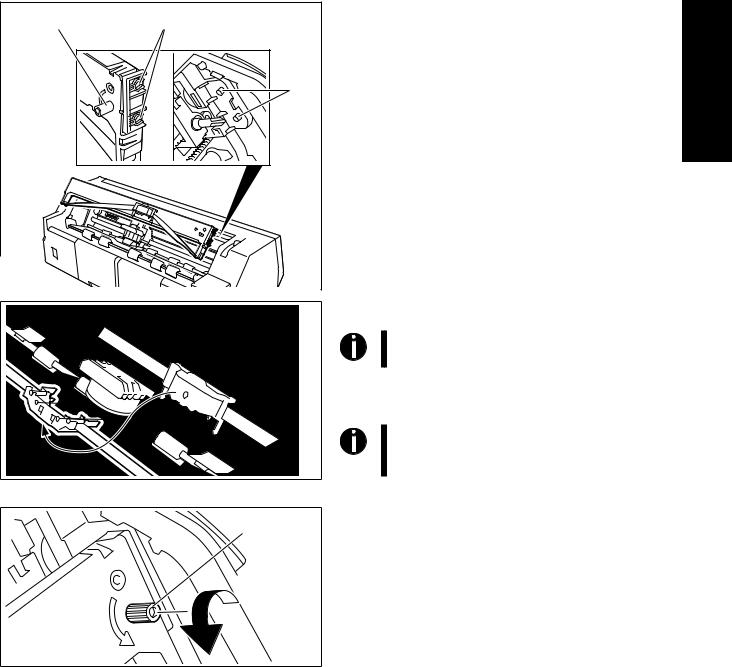
Quick start-up |
Installing the ribbon cassette |
Ribbon Feed Knob |
Part “A” (left side) |
|
Hooks |
Ink-ribbon |
|
cartridge |
|
Ribbon Feed |
Knob |
Align the part “A” on the left side of the Ink-ribbon Cartridge to the two hooks of the printer, push the cartridge all the way until it clicks. If there is resistance, push it while turning the Ribbon Feed Knob.
Detach the Ribbon Guide from the Ink-ribbon Cartridge.
Do not detach the shield that has been attached to the Ribbon Guide; it is necessary to protect the ribbon.
Put the Ribbon Guide between the Print Head and the Platen and push it all the way until it clicks.
When attaching the Ribbon Guide, be careful not to fold the ribbon. Also, pay attention to the shield so that it does not become damaged.
Turn the Ribbon Feed Knob in the direction indicated by the arrow to remove any slack in the ribbon.
ENGLISH
9
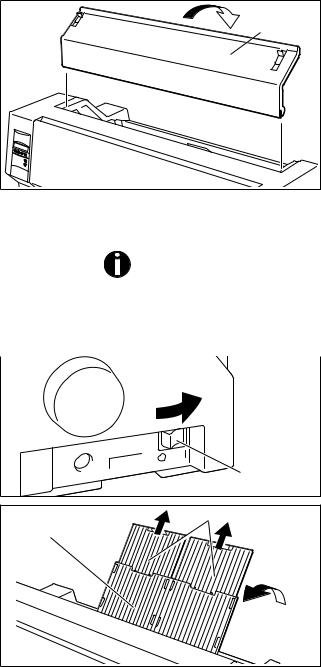
Loading paper |
Quick start-up |
Access |
Cover |
When the Ink-ribbon Cartridge setting is complete, attach the Access Cover.
Set the Paper Thickness Adjustment Lever in accordance with the thickness of the paper to be used. Refer to page 18 (Setting the print head gap).
Loading paper
|
|
Only use paper which is suitable for this printer. For more information, refer to the online |
|
|
|
documentation on the CD-ROM, Appendix C (Specification). |
|
Cut Sheet paper |
|
Cut Sheet Paper is to be inserted from the front of the printer. The post-print paper can be fed out |
|
|
|
from the rear or the front. Please refer to the online documentation on the CD-ROM, Chapter 1, |
|
|
|
Menu description table. |
|
|
|
|
Turn the Power Switch of the printer ON (“ |”). |
|
|
|
|
|
|
|
Adjust the Paper Thickness Lever according to the type of paper |
|
|
|
to be used. Refer to page 18 (Setting the print head gap). |
Power Switch
Paper Extension Trays |
Paper Tray |
10 |
Stand the Paper Tray up in the direction indicated by the arrow. While holding the Paper Tray, pull up the Paper Extension Trays.
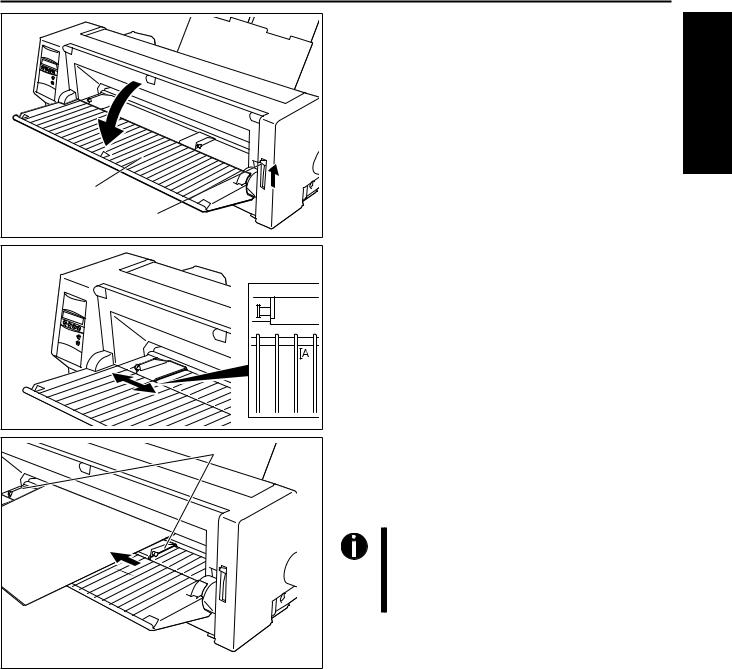
Quick start-up |
Loading paper |
Cut Sheet Insert |
Guide |
Paper Type |
Selection Lever |
Set the Paper Type Selection Lever to Cut Sheet Paper mode. Make sure that the printer is in Single Sheet mode. For how to select Single Sheet mode refer to page 14 (Paper path quick selection).
Determine the left margin by moving the Left Paper Guide left or right. (The “[A” mark indicates the standard print start position.)
ENGLISH
Paper guides |
Cut sheet paper |
Place a sheet of paper aligned to the Left Paper Guide, and adjust the Right Paper Guide to the right edge of the paper.
Insert the paper between the Left and Right Paper Guides. The paper is automatically fed to the print start position and the printer is ready to print.
The paper feed-out capacity is about 30 sheets in case 55Kg-paper (ream) is used and the post-print paper is set to feed out to the rear side. When the post-print paper is set to feed out to the front, the paper must be removed sheet by sheet.
11
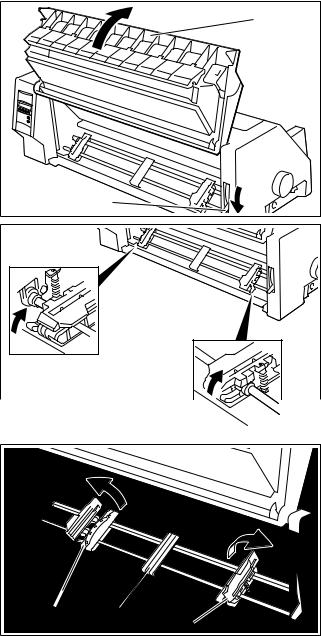
Loading paper |
Quick start-up |
Printer in fanfold paper mode |
Front Cover |
Paper Type |
Selection Lever |
Set the Paper Thickness Adjustment Lever according to the type of paper to be used. Refer to page 18 (Setting the print head gap).
Set the Paper Type Selection Lever to Continuous Form Feed Paper mode.
Open the Front Cover to its upright position until it snaps in. This prevents unexpected closing of the cover.
Stand the Left and Right Tractor Fixing Levers up (in the direction indicated by the arrow), and release the locks.
Open the Flaps of the Left and Right Tractors.
Match the Left and Right Tractors to the paper width.
Locate the Paper Plate in the center between the Left and Right
Tractors.
Tractor
Paper Plate
Tractor
12
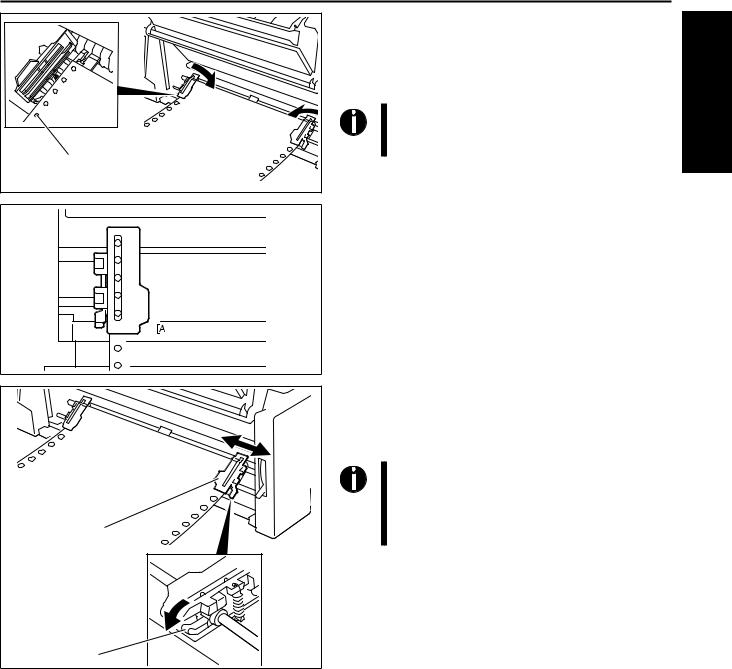
Quick start-up |
Loading paper |
Paper Holes over |
Tractor Pins |
Tractor |
Fixing lever |
With the printing side of the paper facing up, fit the feeding holes on the left edge of the paper over the Left Tractor pins and close the Paper Flap.
Fit the feeding holes on the right edge of the paper over the Right Tractor pins, and close the Paper Flap.
To avoid paper jams, ensure that the same left and right feeding holes are used, and placed over tractor pins of the same level.
After the paper is set, adjust the left margin by moving the Tractors left or right. The “[A” mark is the standard print start position.
Push down the Left Tractor Fixing Lever to lock the Left Tractor.
Move the Right Tractor to remove any paper slack, and then push down the Fixing Lever to lock it in place.
If the paper slack cannot be removed by moving the Right Tractor alone, adjust the position of the Left Tractor.
Be careful not to stretch the paper so much that it tears.
Switch on the printer.
The active feeder (Trac.1) is displayed.
Paper is automatically fed when the printer is in Online status and receives data from the computer.
Press the Load key to load paper before printing.
ENGLISH
13

Changing the paper type |
Quick start-up |
Changing the paper type
Paper path quick selection
Offline |
Trac.1 |
Park |
Load |
Single |
Trac.1 |
Offline |
Single |
Park |
|
Turn paperlever |
Load paper from |
Single |
You can change the paper type (the paper path) either using the paper path quick selection feature or via the Setup menu.
First cut the fed-out portion of a Continuous Form Feed Paper at the perforated line. To do this, proceed as follows.
Online |
Make sure that the printer is in Offline status; press the Online key, if necessary. |
|||
|
Press the Park key. |
|||
Setup |
If fanfold paper is in the printer, it is transported to the tear position. “Tear paper |
|||
off” appears on the display. Press any key. |
||||
|
||||
|
If a single sheet is loaded in the printer, it is ejected. |
|||
Online |
Select the desired paper path by pressing one of the I keys, in our example Single. |
|||
Setup |
|
|
If you do not make a selection within 5 seconds, the printer exits |
|
|
|
|||
|
|
the menu. |
||
|
|
|
||
Online |
The printer returns to Offline mode. |
|||
|
The display toggles between… |
|||
Setup |
|
|
|
|
|
and… |
|||
Online |
Set the Paper Type Selection Lever to Cut Sheet Paper mode (see page 11 Loading |
|||
|
paper). |
|||
Setup |
|
|
|
|
Online |
The display toggles between… |
|||
Setup |
|
|
|
|
|
and… |
|||
Offline |
Single |
Park |
|
Online
Setup
Stand the Paper Tray up in the direction indicated by the arrow. While holding the Paper Tray, pull up the Paper Extension Trays.
Determine the left margin by moving the Left Paper Guide left or right.
Place a sheet of paper aligned to the Left Paper Guide, and adjust the Right Paper Guide to the right edge of the paper. Insert the paper between the Left and Right Paper Guides. The paper is automatically fed to the print start position (see page 11
Loading paper).
14
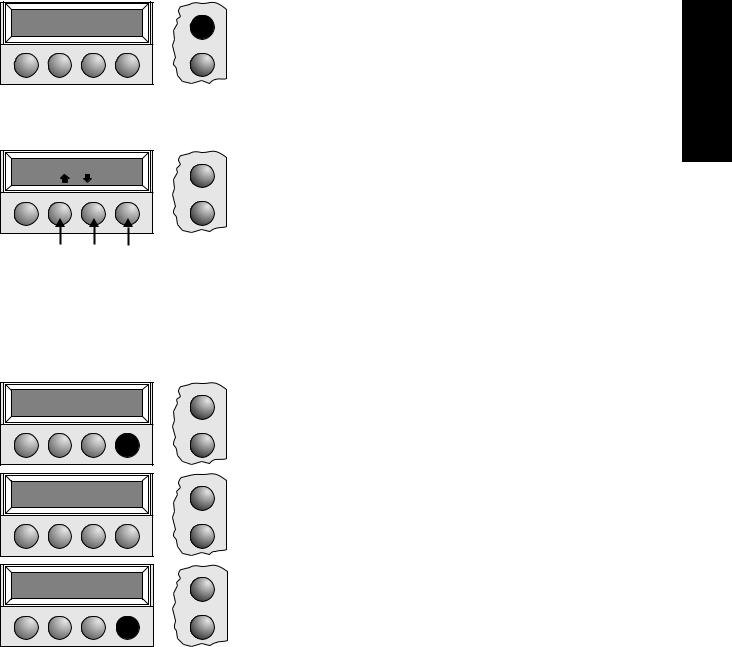
Quick start-up |
Paper transport |
Online |
Single |
Paper transport
Offline |
Trac.1 |
Park |
LF/FF |
|
|
Online Press the Online key to make the printer ready for operation.
Setup
Loaded paper (fanfold paper/single sheets) can be transported in the printer in different ways.
Online |
Make sure that the printer is in Offline status; press the Online key, if |
|
necessary. |
Setup |
Short keypress: Line feed (LF) is initiated |
|
Long keypress: Form feed (FF) is initiated |
Short keypress: Paper is transported downwards step by step Long keypress: Continuous transport down
Short keypress: Paper is transported upwards step by step Long keypress: Continuous transport up
Using
Moving paper to the Fanfold paper can be transported to the tear position by pressing the Tear key. tear position
Online |
Trac.1 |
Online |
Make sure that the printer is in Online status. |
|
Press the Tear key. The printer moves the perforation edge of the fanfold paper |
||
|
Tear |
|
|
|
|
to the tear edge. |
|
|
|
Setup |
|
|
|
|
|
|
|
|
The display toggles between… |
Tear position |
Online |
|
|
|
|
||
Tractor1 |
|
|
|
|
|
Setup |
|
|
|
|
and… |
Online |
Tear |
Online |
Press the Exit key after having torn off the paper. The printer moves the paper |
|
back to the first printing position. |
||
|
Exit |
|
|
|
|
|
|
|
|
Setup |
|
ENGLISH
15

Settings (I) |
Quick start-up |
Settings (I)
Setting the tear position
Offline |
Trac.1 |
Park |
LF/FF |
Adjust |
Paperway |
Menu |
Char |
TOF |
Tear |
TearAdj=00/72" * |
|
Set |
Exit |
If the tear position of the paper is not aligned with the tear edge of the printer, you can adjust it.
Online |
Press the Setup key. The printer changes to Setup mode. |
Setup |
|
Online |
Press the Adjust key. |
Setup |
|
Online |
Press the Tear key. |
Setup |
|
Online |
Press the < or > key to move the perforation to the appropriate position. |
|
Confirm the setting by pressing the Set key. The printer returns to its initial status. |
Setup |
|
Setting the first printing line (TOF)
Adjust |
Paperway |
Menu |
Char |
The correction made (a maximum of approx. 2.5 cm [1"] in both directions) will be retained after printer power-off.
You can use the TOF function to set the position of the topmost printing line individually for each paper source and each menu.
You should adjust the tear position (see above) before using the TOF function (when using fanfold paper).
Online Press the Setup key. The printer changes to Setup mode.
Setup
16
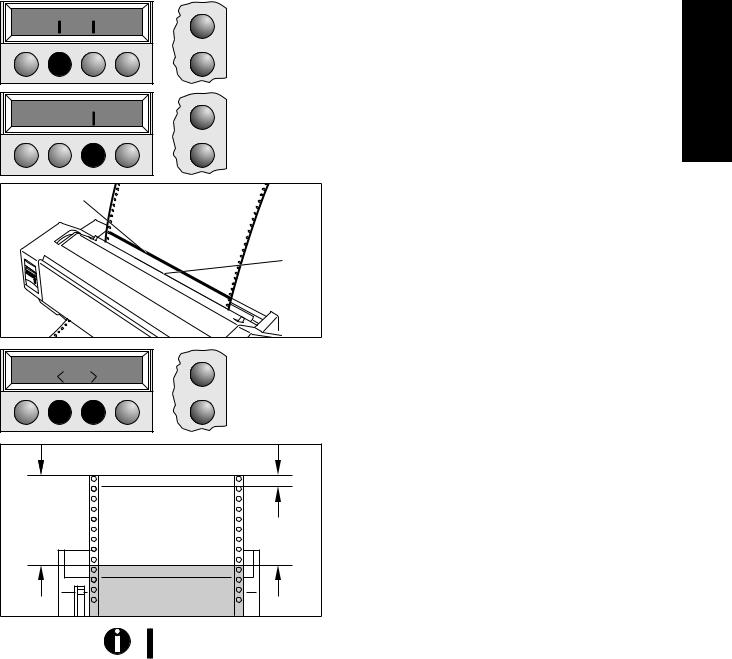
Quick start-up |
Settings (I) |
Adjust |
Paperway |
Online |
Press the Adjust key. |
|
|
||
Menu |
Char |
|
|
|
|
Setup |
|
|
TOF |
Online |
Press the TOF key. |
|
|
|
|
|
Tear |
|
|
|
|
Setup |
|
|
A |
|
The bottom edge of the currently valid first printing line A of the |
|
|
|
paper is transported to the tear edge B. |
|
|
|
The factory setting for the first printing position is 12/72". |
|
|
|
B |
FormAdj=12/72" * |
Online |
Press the < or > key to move the first printing line to the appropriate position. |
|
|
You can set values from 0 to 220/72" for fanfold paper, from 0 to 72/72" for single |
||
Set |
Exit |
|
|
|
sheets. |
||
|
|
Setup |
|
|
|
|
|
Standard 1. print line |
12/72" |
Newly set 1. print line |
|
Confirm the setting by pressing the Set key. The printer returns to its initial status.
The setting made will be retained after printer power-off. For more detailed information, refer to the online documentation on the CD-ROM, chapter 3 (Mechanical adjustments to the printer).
ENGLISH
17
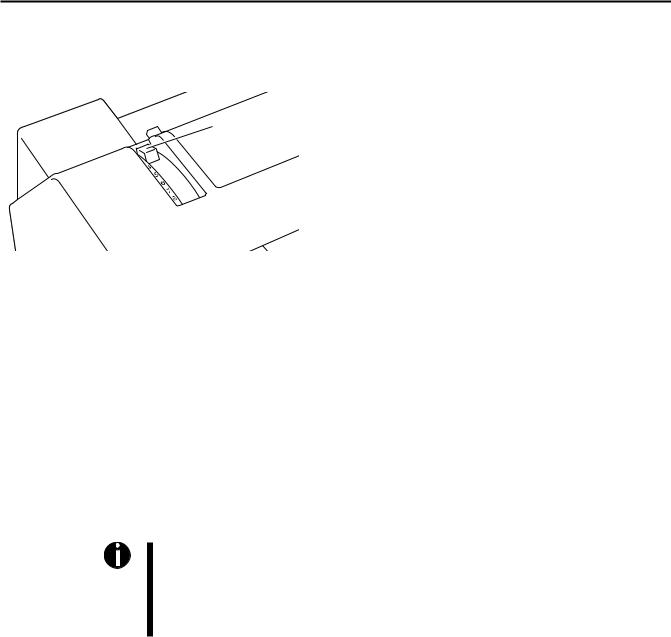
Settings (II) Quick start-up
Settings (II)
Setting the print |
The printer has been provided with a Paper Thickness Adjustment Lever for adjusting the print |
|
head gap |
head gap |
|
|
|
To obtain optimum print quality, the gap between the Print Head |
|
|
|
|
Paper Thickness |
and the Platen needs to be adjusted according to the thickness |
|
of the paper to be used. |
|
|
Adjustment Lever |
|
|
|
|
The following table shows the adjustable range:
Number of Copies/ |
Ream (kg) |
g/m2 |
Lever Position |
Thickness of Paper |
|
|
|
Original only Thin |
45–55 |
50–65 |
1 |
Normal |
55–77 |
65–90 |
1–2 |
Thick |
77–110 |
90–130 |
2 |
Original + 1 |
34/34 |
40/40 |
2–3 |
Original + 2 |
34/34/34 |
40/40/40 |
2–4 |
Original + 3 |
34/34/34/34 |
40/40/40/40 |
3–4 |
|
|
|
|
Original + 4 |
34/34/34/34/34 |
40/40/40/40/40 |
4–5 |
|
|
|
|
Original + 5 |
34/34/34/34/34/34 |
40/40/40/40/40/40 |
5–6 |
|
|
|
|
Postal Card |
110 |
130 |
3 |
|
|
|
|
Reserved |
— |
— |
7–8 |
|
|
|
|
1.“Ream” is a unit of paper thickness, indicating the weight in kg, of 1,000 cut sheets at 788 mm x 1091 mm.
2.When printing the original sheet only, Cut Sheet Paper of 45 kg and thicker or Continuous Form Feed Paper of 50 kg and thicker can be used.
3.When the Paper Thickness Adjustment Lever is set higher than appropriate, the printout will appear scratchy and the print head and ribbon lives will be shortened.
18
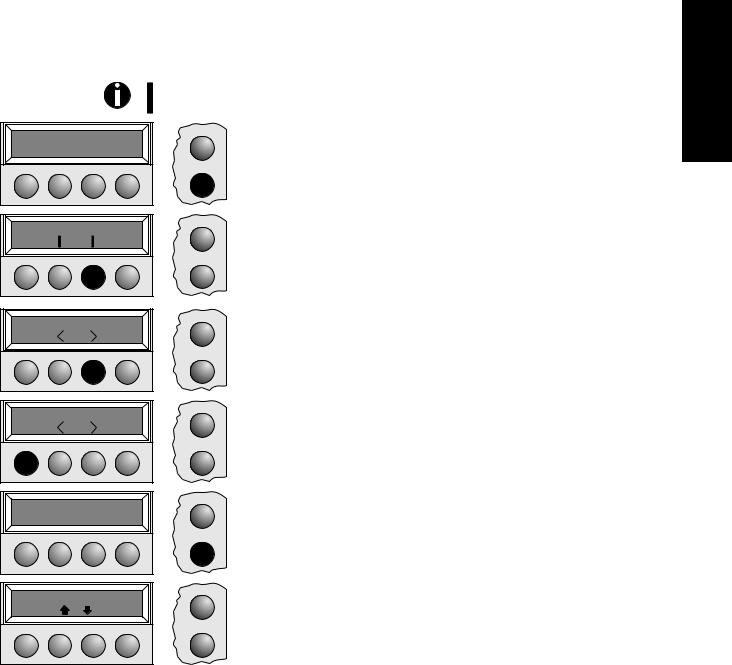
Quick start-up |
Settings (II) |
Changing paper in Setup mode
From fanfold paper When fanfold paper was in use and you want to change over to single sheet mode, proceed as
to single sheet mode described below.
You do not need to remove the fanfold paper.
Online |
Trac.1 |
|
Load |
Adjust |
Paperway |
Menu |
Char |
Tractor 1 |
* |
Set |
Exit |
Single |
|
Set |
Exit |
Tear paper off |
Press any key |
Offline |
Single |
Park |
Load |
Online
Setup
Online
Setup
Online
Setup
Online
Setup
Online
Setup
Online
Setup
Cut the fed-out portion of the Continuous Form Feed Paper at the perforated line. To do this, proceed as follows.
Press the Setup key. The printer changes to Setup mode.
Press the Paperway key. The printer changes to the paper path menu.
Press < or > to change to Single (sheet) operating mode.
The currently valid setting (Tractor 1) is marked by a “ *”.
Confirm the setting by pressing the Set key.
The input is acknowledged by an acoustic signal and the fanfold paper is transported to the tear position. Cut the fed-out portion of the Continuous Form Feed Paper at the perforated line.
In the display appears…
Press any key.
The printer returns to its initial status and the fanfold paper is transported to the park position.
The display toggles between…
and…
ENGLISH
19
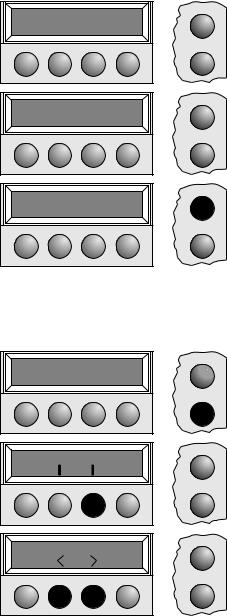
Settings (II) |
Quick start-up |
Turn paperlever |
Load paper from |
Single |
Online |
Single |
Online
Setup
Online
Setup
Online
Setup
Set the Paper Type Selection Lever to Cut Sheet Paper mode.
In the display appears…
Stand the Paper Tray up and pull up the Paper Extension Trays (see page 10). Place a sheet of paper aligned to the Left Paper Guide, and adjust the Right Paper Guide to the right edge of the paper.
Insert the paper between the Left and Right Paper Guides. The paper is automatically fed to the print start position (see page 11).
Press the Online key to make the printer ready for operation.
From single sheet to fanfold paper mode
Online |
Single |
Adjust |
Paperway |
Menu |
Char |
Single |
* |
Set |
Exit |
When single sheets were in use and you want to change over to fanfold paper mode, proceed as described below.
Make sure that fanfold paper is loaded. Refer to page 12 (Loading Fanfold Paper) for details.
Online Pull down the Paper Extension Trays and fold the Paper tray down.  Press the Setup key. The printer changes to Setup mode.
Press the Setup key. The printer changes to Setup mode.
Setup
Online Press the Paperway key. The printer changes to the paper path menu.
Setup
Online |
Press < or > to change to Trac.1 (fanfold paper) mode. |
The currently valid setting (Single) is marked by a “ *”.
Setup
20
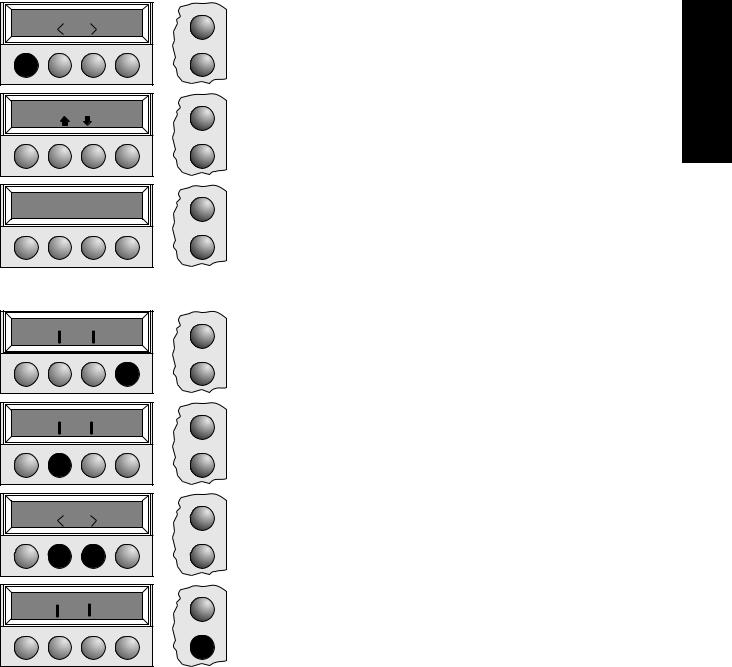
Quick start-up |
Settings (II) |
Tractor1 |
|
Set |
Exit |
Offline |
Trac.1 |
Park |
LF/FF |
Turn paperlever |
Online
Setup
Online
Setup
Online
Setup
Confirm the setting by pressing the Set key. An acoustic signal acknowledges the input.
The display toggles between…
and…
Shift the Paper Type Selection Lever to the position needed. The printer is now ready for printing fanfold paper.
Press the Online key to make the printer ready for operation.
Selecting a font
Adjust |
Paperway |
Menu |
Char |
Font |
CPI |
DRAFT COPY |
* |
Set |
Exit |
Font |
CPI |
You can use the Font key to select fonts in Setup mode.
Online |
Press the Setup key. |
|
Press the Char key. |
Setup |
|
Online |
Press the Font key. |
Setup |
|
Online |
Press the < or > key to select the desired font. |
|
Confirm your selection by pressing the Set key. |
Setup |
|
Online |
Press the Setup key. The printer returns to its initial status. |
|
You can also press the Online key. The printer changes directly in Online mode. |
Setup |
|
ENGLISH
21
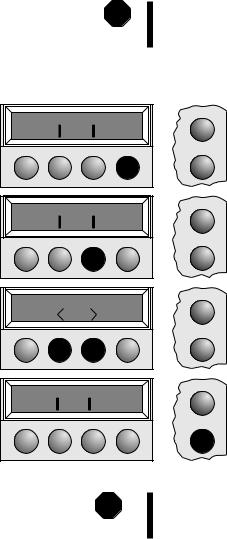
Settings (II) |
Quick start-up |
STOP
The selection made will not be retained after printer power-off. For information on how to select a font permanently, refer to online documentation on the CD-ROM, chapter 1 (Menu description table).
Setting the character pitch
Adjust |
Paperway |
Menu |
Char |
Font |
CPI |
10 CPI |
* |
Set |
Exit |
Font |
CPI |
You can use the CPI key to set the character pitch in Setup mode.
Online |
Press the Setup key. |
|
Press the Char key. |
Setup |
|
Online |
Press the CPI key. |
Setup |
|
Online |
Press the < or > key to select the desired pitch. |
|
Confirm your selection by pressing the Set key. |
Setup |
|
Online |
Press the Setup key. The printer returns to its initial status. |
|
You can also press the Online key. The printer changes directly in Online mode. |
Setup |
|
STOP
The selection made will not be retained after printer power-off. For information on how to select a font permanently, refer to online documentation on the CD-ROM, chapter 1 (Menu description table).
22
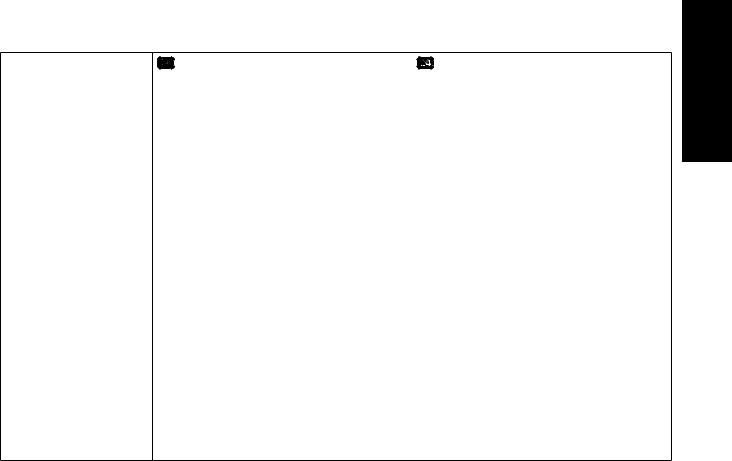
Quick start-up |
Specifications |
Specifications
Printer specifications
Printing method
Print width
Print speed
(bidirectional)
Character densities Graphics print density Ribbon life
Acoustic noise levell Dimensions
Weight
Power supply
Power consumption
Operating environment
Print head specifications
Interface buffer
Regulations
serial printing with 9-pin matrix print head |
serial printing with 24-pin matrix print head |
||||
narrow printer |
|
80 characters at 10 cpi |
narrow printer |
|
80 characters at 10 cpi |
wide printer |
|
136 characters at 10 cpi |
wide printer |
|
136 characters at 10 cpi |
HS-Draft/Draft Copy |
360 cps at 10 cpi |
HS-Draft/Draft Copy |
330 cps at 10 cpi |
||
Draft |
|
270 cps at 10 cpi |
Draft |
|
250 cps at 10 cpi |
NLQ/LQ |
|
65 cps at 10 cpi |
NLQ/LQ |
|
70 cps at 10 cpi |
5, 6, 7,5, 8,6, 10, 12, 15, 17.1, 20 cpi |
5, 6, 7,5,8,6, 10, 12, 15, 17.1, 20 cpi |
||||
horizontal 240 dpi / vertical 144 dpi |
horizontal 360 dpi / vertical 180 dpi |
||||
4 million char. |
|
|
4 million char. |
|
|
ca. 55 dB (A) |
|
|
ca. 55 dB (A) |
|
|
narrow printer |
485 x 206 x 245 mm (W x H x D) |
narrow printer |
485 x 206 x 245 mm (W x H x D) |
||
wide printer |
625 x 206 x 245 mm (W x H x D) |
wide printer |
625 x 206 x 245 mm (W x H x D) |
||
narrow printer 9 kg / wide printer 11 kg |
narrow printer 9 kg / wide printer 11 kg |
||||
USA/Canada |
|
AC 120 V ±10% / 60 Hz ±3% |
USA/Canada |
|
AC 120 V ±10% / 60 Hz ±3% |
Europe |
|
AC 230 V ±10% / 5 0 Hz ±3% |
Europe |
|
AC 230 V ±10% / 5 0 Hz ±3% |
at 100% throughput |
< 60 VA |
at 100% throughput |
< 60 VA |
||
in the Ready state |
< 10 VA |
in the Ready state |
< 10 VA |
||
Temperature |
|
10°C to 40°C |
Temperature |
|
10°C to 40°C |
Humidity |
|
20% to 80% |
Humidity |
|
20% to 80% |
Number of pins |
|
9 |
Number of pins |
|
24 |
Pin diameters |
|
0,3 mm |
Pin diameters |
|
0,2 mm |
Number of copies |
1 original + 5 copies |
Number of copies |
1 original + 3 copies |
||
max. 40 kB |
|
|
max. 40 kB |
|
|
UL 1950, VDE-GS, CE, FCC Class B, UL/ULc |
UL 1950, VDE-GS, CE, FCC Class B, UL/ULc |
||||
|
|
|
|
|
|
Paper specifications
Cut sheets |
Paper weight |
60 |
– 120 g/m2 |
|
Width |
narrow printer: 76 – 220 mm / wide printer: 76 – 420 mm |
|
|
Length |
76 |
– 559 mm |
Fanfold paper |
|
|
– 120 g/m2 |
Simple forms |
Paper weight |
60 |
|
|
Width |
narrow printer: 76 – 254 mm / wide printer: 76 – 420 mm |
|
Sets of forms |
Length |
76 |
– 559 mm |
Paper weight |
original: 45 – 65 g/m2 / copy: 45 – 56 g/m2 / last page: 45 – 65 g/m2 |
||
|
Width/Length |
see simple forms |
|
|
Form thickness |
max. 0,5 mm |
|
|
Number of copies |
1+5 (9 wire) / 1+3 (24 wire) |
|
|
|
|
|
ENGLISH
23

Accessories |
Quick start-up |
Accessories
For more information on printer specifications and paper specifications, refer to the online documentation on the CD-ROM.
Ribbon cassettes |
|
Narrow printer: |
Part No. 044 829 |
Wide printer: |
Part No. 044 830 |
24
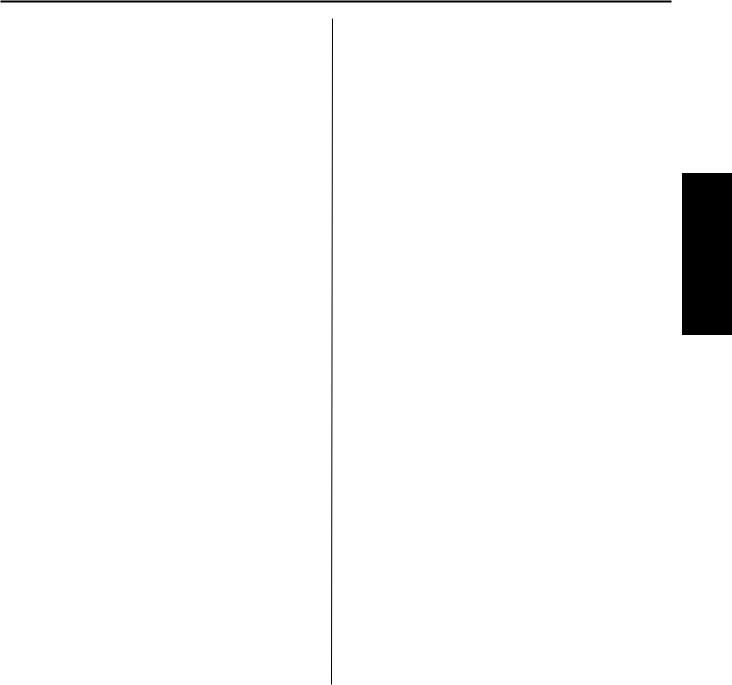
Der schnelle Einstieg
Bedienungsanleitung |
Inhaltsverzeichnis |
|
|
|
|
||
DER SCHNELLE |
Einführung |
2 |
|
|
|||
EINSTIEG |
Zu den verwendeten Symbolen |
2 |
|
Wichtige Sicherheitshinweise |
2 |
||
|
|||
|
Arbeiten mit der Online-Dokumentation |
2 |
|
|
Auf einen Blick |
3 |
|
|
|||
|
Installation |
5 |
|
|
Drucker auspacken |
5 |
|
|
Drucker aufstellen |
5 |
|
|
Drucker anschließen |
6 |
|
|
Drucker einund ausschalten |
6 |
|
|
Bedienfeld |
7 |
|
|
Online-Modus |
7 |
|
|
Offline-Modus |
7 |
|
|
Setup-Modus |
7 |
|
|
Farbbandkassette auswechseln |
8 |
|
|
Papier einlegen |
10 |
|
|
Einzelblattpapier |
10 |
|
|
Drucker im Endlospapierbetrieb |
12 |
|
|
Papierart wechseln |
14 |
|
|
Schnellumschaltung Papierweg |
14 |
|
|
Papiertransport |
15 |
|
|
Handhabung |
15 |
|
|
Papier in Abreißposition fahren |
15 |
|
|
Einstellungen (I) |
16 |
|
|
Abreißpositioneinstellen |
16 |
|
|
Erste Druckzeile einstellen (TOF) |
16 |
|
|
Einstellungen (II) |
18 |
|
|
Druckkopfabstand einstellen |
18 |
|
|
Papierwechsel im Setup-Modus |
19 |
|
|
Von Endlospapierin Einzelblattbetrieb |
19 |
|
|
Von Einzelblattin Endlospapierbetrieb |
20 |
|
|
Schriftart wählen |
21 |
|
|
Zeichendichte einstellen |
22 |
|
|
Technische Daten |
23 |
|
|
Druckerspezifikationen |
23 |
|
|
Papierspezifikationen |
23 |
|
|
Zubehör |
24 |
DEUTSCH
1

Einführung |
Der schnelle Einstieg |
Einführung
Ah ha!
Zu den verwendeten Symbolen
STOP
Diese Bedienungsanleitung dient dem schnellen Einstieg in das Arbeiten mit dem Drucker und soll auch dem ungeübten Benutzer den Umgang mit dem Gerät ermöglichen. Sie beschreibt die wichtigsten Funktionen des Druckers und enthält unerläßliche Informationen für die alltägliche Arbeit mit dem Gerät. Eine ausführliche Beschreibung des Druckers, seiner Leistungsmerkmale und weiterführende Informationen enthält das Referenzhandbuch auf der Online-CD-ROM, die Sie auf der vorletzten Seite dieser Bedienungsanleitung finden.
In der Bedienungsanleitung werden zwei Arten besonderer Hinweise verwendet, um wichtige Informationen hervorzuheben.
VORSICHT enthält Informationen, die beachtet werden müssen, um den Benutzer vor Schaden zu bewahren und Schäden am Drucker zu verhindern.
HINWEIS enthält allgemeine oder zusätzliche Informationen zu einem bestimmten Thema.
Wichtige Sicherheitshinweise
STOP
STOP
Lesen Sie die folgenden Hinweise genau durch, bevor Sie den Drucker in Betrieb nehmen. Dadurch schützen Sie sich und vermeiden Schäden an dem Gerät.
Bewahren Sie diese Bedienungsanleitung an einem jederzeit zugänglichen Ort auf.
Den Drucker auf stabilem Untergrund so aufstellen, daß er nicht zu Boden fallen kann.
Den Drucker weder hohen Temperaturen noch direktem Sonnenlicht aussetzen.
Keine Flüssigkeiten mit dem Drucker in Berührung bringen.
Den Drucker keinen Erschütterungen, Stößen oder Vibrationen aussetzen.
Den Drucker nur an eine Steckdose mit der richtigen Wechselspannung anschließen.
Führen Sie Wartungsarbeiten und Reparaturen keinesfalls selbst aus, sondern verständigen Sie immer einen qualifizierten Servicetechniker.
Wenn Sie den Drucker vom Netz trennen wollen, immer den Netzstecker an der Steckdose ziehen.
Weitere Sicherheitshinweise finden Sie an entsprechender Stelle im Text.
Arbeiten mit der On- Installieren Sie zuerst den Adobe Acrobat Reader auf Festplatte, falls dieses Programm nicht line-Dokumentation schon vorhanden ist. Befolgen Sie zur Installation die in der Readme-Datei im Verzeichnis READER aufgeführten Schritte. Doppelklicken Sie zum Starten der Online-Dokumentation im Datei-Manager (Windows 3.1) oder Explorer (Windows 95/Windows 98/Windows NT) auf die
Datei START.PDF. Folgen Sie dann der Bedienerführung.
Für den Fall, daß die CD-ROM fehlerhaft ist oder fehlt, wenden Sie sich bitte an -Ihren Händler. Die Online-Dokumentation ist auch in gedruckter Form (gegen -Gebühr) oder im Internet erhältlich.
Hardwarevoraussetzungen mindestens: PC AT 486, 4-fach CD-ROM, 15"-Bildschirm, Maus.
Fehlersuche |
Die Online-Dokumentation auf CD-ROM enthält ausführliche Informationen zur Fehlersuche. |
2
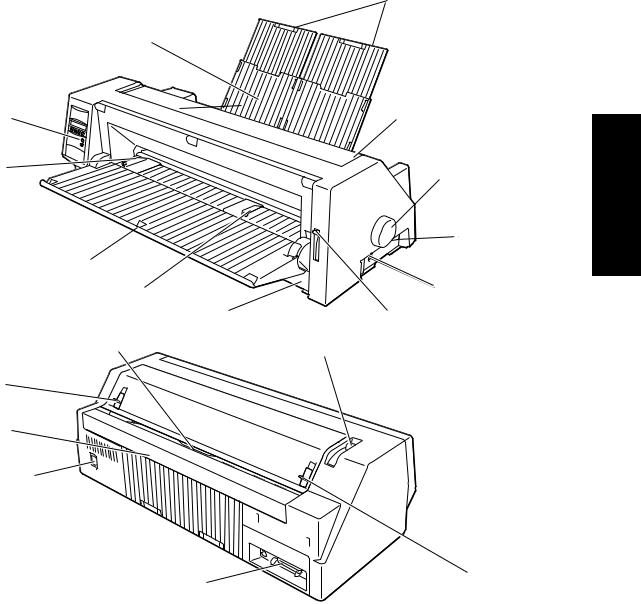
Der schnelle Einstieg |
Auf einen Blick |
Auf einen Blick In den folgenden Abbildungen sind alle Druckerteile aufgeführt, die sich daran anschließende
Tabelle listet die Funktionen dieser Teile auf.
Papierablage
Bedienfeld
Linker Randsteller
Einzelblatteinzug
Rechter Randsteller
Frontklappe
Papierabreißkante
Papierdickenhebel
Rasthebel
Hintere
Abdeckleiste
Papierstützen
Obere Abdeckung
Handrad
Netzschalter
Optionenbuchse
Papierwahlhebel
Netzanschluß
Schnittstellenbuchse |
Rasthebel |
|
DEUTSCH
3

Auf einen Blick |
Der schnelle Einstieg |
|
|
|
|
|
Bezeichnung |
Funktion |
|
Bedienfeld |
Zeigt den Druckerstatus an; wird verwendet, um zahlreiche Einstellungen |
|
|
vorzunehmen. |
|
|
|
|
Papierablage |
Wird als Papierablage für schon bedruckte Einzelblätter verwendet, wenn |
|
|
der Parameter „F-Eject“ in den Menüeinstellungen auf AUS gesetzt ist. |
|
|
|
|
Papierstützen |
Dienen zur Verlängerung der Papierablage. |
|
|
|
|
Obere Abdeckung |
Soll eine Farbbandkassette ersetzt, oder muß ein Papierstau beseitig |
|
|
werden, kann diese Abdeckung entfernt werden, um Zugang zu den |
|
|
betroffenen Teilen zu erhalten. Dient außerdem dem Schutz des |
|
|
Bedieners vor den mechanischen Bewegungen im Drucker. |
|
|
|
|
Handrad |
Wird verwendet, um Papier manuell vor oder zurückzubewegen. |
|
|
|
|
Netzschalter |
Schaltet den Drucker EIN oder AUS. |
|
|
|
|
Optionenbuchse |
Wird verwendet, um die automatische Einzelblattzuführung (ASF) oder |
|
|
den optionalen zweiten Traktor anzuschließen. |
|
|
|
|
Papierwahlhebel |
Wird verwendet, um die vom Drucker zu verarbeitende Papierart zu |
|
|
wählen: |
|
|
Einzelblattpapier (Hebel in oberer Position) |
|
|
Endlospapier (Hebel in unterer Position) |
|
Frontklappe |
Wird geöffnet, wenn Endlospapier eingelegt werden soll. Diese Klappe ist |
|
|
abgenommen, wenn die automatische Einzelblattzuführung (ASF) oder |
|
|
der optionale zweite Traktor angebracht ist. |
|
|
|
|
Rechter Randsteller |
Durch Ausrichten des rechten Rands eines Einzelblatts an dieser Führung |
|
|
kann ein ungleichmäßiger Papiereinzug verhindert werden. |
|
|
|
|
Einzelblatteinzug |
Wird geöffnet, um Einzelblätter einzuführen und dient als Papierstütze. |
|
|
Wird außerdem als Ablage für bedrucktes Papier verwendet, wenn der |
|
|
Parameter „F-Eject“ in den Menüeinstellungen auf ASF, Single oder ALL |
|
|
gesetzt ist. |
|
|
|
|
Linker Randsteller |
Dient der Ausrichtung des linken Rands von Einzelblättern. |
|
|
|
|
Rasthebel |
Ziehen der Hebel in Richtung Druckervorderseite öffnet die Verriegelung |
|
|
und die obere Abdeckung kann geöffnet werden. |
|
|
|
|
Papierabreißkante |
An dieser Stelle wird Endlospapier abgerissen. Drücken der Taste Tear |
|
|
transportiert das Papier bis zu dieser Position. |
|
Papierdickenhebel |
Wird verwendet, um den Druckkopfabstand in Überein- |
|
|
stimmung mit der verwendeten Papierdicke einzustellen. Einzelheiten |
|
|
siehe Seite 18, Druckkopfabstand einstellen. |
|
Schnittstellenbuchse |
Hier wird das Kabel für den Anschluß an den Computer eingesteckt. |
|
|
|
|
Netzanschlußbuchse |
Hier wird das Netzkabel angeschlossen. |
|
|
|
|
Hintere Abdeckleiste |
Dient zur Geräuschdämmung am Drucker. Muß abgenommen werden, |
|
|
wenn die Papierablage hochgeklappt wird. |
|
|
|
4
